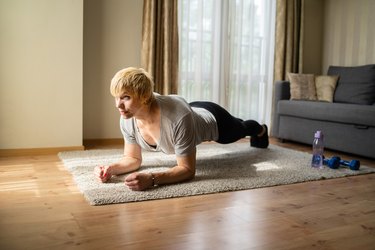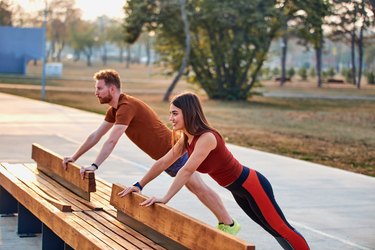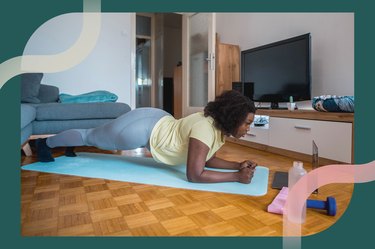
HIIT circuit, boot camp classes, strength training sessions — planks tend to find their way into almost every workout. And for good reason. Not only do they fire up your core, but your shoulders and legs, too. That's why, to do them correctly, you need muscular strength and endurance from head to toe.
But why are planks so hard? (We repeat, so hard.) If you're struggling to sustain a 30-second plank, don't sweat it. Once you pinpoint the problem, you can focus on fixing it. Here, Geoff Tripp, CSCS, certified personal trainer and head of fitness at Trainiac, shares what might be holding you back from holding a plank, plus advice to help you improve your plank performance.
Video of the Day
Related Reading
The Most Common Reasons You Can’t Hold a Plank
As we mentioned above, planks are hard. Why is it so difficult to do a plank? It's because this is a full-body move that works your back, core and lower-body muscles, according to the Cleveland Clinic.
Three of the most common reasons you can't hold a plank are your core and upper-body muscles are weak and/or you're not engaging your glutes and quads. We outline these reasons — and what you can do about them — below.
But before we do that, you may be wondering a few things. First up: Do planks ever get easier?
The good news is yes, they do! By doing certain exercises to build up the strength needed to hold a plank (more on that below), practicing plank modifications (like a plank on your knees) and then holding a plank for a little at a time, you'll be able to successfully nail the move.
Another common question is how long you should be able to hold a plank? According to the Cleveland Clinic, you should be able to hold a plank for about a minute.
For beginners who are new to planking, the amount of time you can hold it will be different for everyone. Start where you are and each time you plank, try to increase your time in 5- to 10-second increments, according to the Cleveland Clinic. Practicing planking between two and four times a week is helpful, the Cleveland Clinic explains.
Last up before we dive in: Why do you shake when planking? As LIVESTRONG.com previously reported, new exercises or exercises where you're giving max effort can cause your muscles to shake. This is because you're demanding more effort than usual from your muscle fibers.
1. Your Hips Are Sagging
If your core muscles are weak, holding a 30-second plank is going to be a struggle. "Poor rectus abdominal and oblique strength limit your ability to properly support the midsection of your plank," Tripp says. That results in your hips sagging in an attempt to lighten the load for your abs. But this throws off proper form and places too much pressure on your lower back. Ouch!
But while doing a ton of crunches can help strengthen your abs, but it won't improve your ability to hold a plank. "Having a well-balanced strength and conditioning program that is designed to not only develop your plank holds, but also address specific muscle weakness is key," Tripp says.
Fix It
With that in mind, start with elevated planks with your hands on a bench, Tripp says, who adds that doing the move at an angle makes it easier. Once you build core strength, transition to the floor. Begin by performing several reps of short, 10-second plank holds — to focus on perfecting form — then gradually increase your time to 20- and 30-second holds.
Banded Pallof Press
The Pallof press, also called the standing core press, is another effective exercise to train your abs and prepare your core for planks, Tripp says.
- Anchor a resistance band around a stable object at waist height.
- Grab the band with both hands and step out to the side to create tension in the band. Brace your core to tuck your tailbone.
- Keep your core engaged as you press your hands forward and away from you. Don't let your body rotate!
- Pause, then slowly bring your hands back to start.
- Do all reps, then switch sides.
2. You Can’t Maintain Neutral Alignment
Believe it or not, your core consists of many muscles between your shoulders and knees, including your glutes and your quads. And during a plank, you need to actively squeeze your butt and legs to keep your whole body aligned.
"Not engaging your glutes and quads will hinder how well you can tuck your pelvis and maintain a neutral spine," Tripp says. That's because these muscles act together to pull the pelvis into a neutral position, which helps to hold your body in a straight line from your head to your toes and reduces your hips from dipping too.
While you don't need to squat 300 pounds to nail your plank, having some lower-body awareness and knowing how to engage the correct muscles is key to perfecting your plank form and avoiding excess pressure on your back, Tripp says.
Fix It
Moves like squats, deadlifts, glute bridges and lunges will aid in the activation of your glutes, quads and hamstrings.
"I personally like glute bridges and split squats because they work the lower body unilaterally and require mindfulness of your core to maintain balance and a neural body alignment," Tripp says.
Glute Bridge
Glute bridges work your lower body unilaterally and requires mindfulness of your core to maintain balance and a neutral body alignment, according to Tripp.
- Lie on the ground with your knees bent, feet close to your butt and arms at your sides. Brace your core.
- Press into your feet and arms to lift your hips and lower and mid-back off the ground.
- Pause, focusing on squeezing your glutes.
- Lower back down to the start.
Split Squat
Split squats also strengthen your lower-body muscles unilaterally, and Tripp recommends them for the same reason he loves the glute bridge.
- Stand with one foot a few feet in front of the other and clasp your hands together in front of your chest.
- Brace your core. Keeping your torso tall, bend both knees to lower down as far as comfortable.
- Straighten both legs to stand up.
- Do all reps, then switch sides.
3. Your Shoulder Blades Pop Up
If your shoulder blades are "winged" think: not flat, but rather sticking up like wings) during a plank, you need to push harder off the ground. But if that's too difficult, you probably have weak shoulders and upper-body muscles, which can limit your ability to perform the pushing motion, Tripp says.
When you do a plank, many muscles (including deltoids, pectorals, triceps, trapezius and lats) must work in concert to allow you to press away from the ground as well as maintain stability in the shoulder joint, Tripp says. In other words, without a strong upper body, you won't be able to master proper form or hold a plank for very long.
Fix It
The best way to gain upper-body strength?
"Any pressing movement will aid in the development of your shoulder and upper body muscles," Tripp says.
Incline Push-Up
Tripp recommends practicing push-ups because the move is just an active plank. Start with incline push-ups to prevent overloading yourself and having form issues.
- Place your hands flat on a sturdy box or bench with your hands about shoulder-width apart.
- Walk your feet back until your body forms a straight line from your heels to your shoulders. Brace your core.
- Bend your elbows to form a 45-degree angle with your trunk, lowering as far as comfortable.
- Pause, then press through your hands to raise your torso to start.
Was this article helpful?
150 Characters Max
0/150
Thank you for sharing!
Thank you for your feedback!


